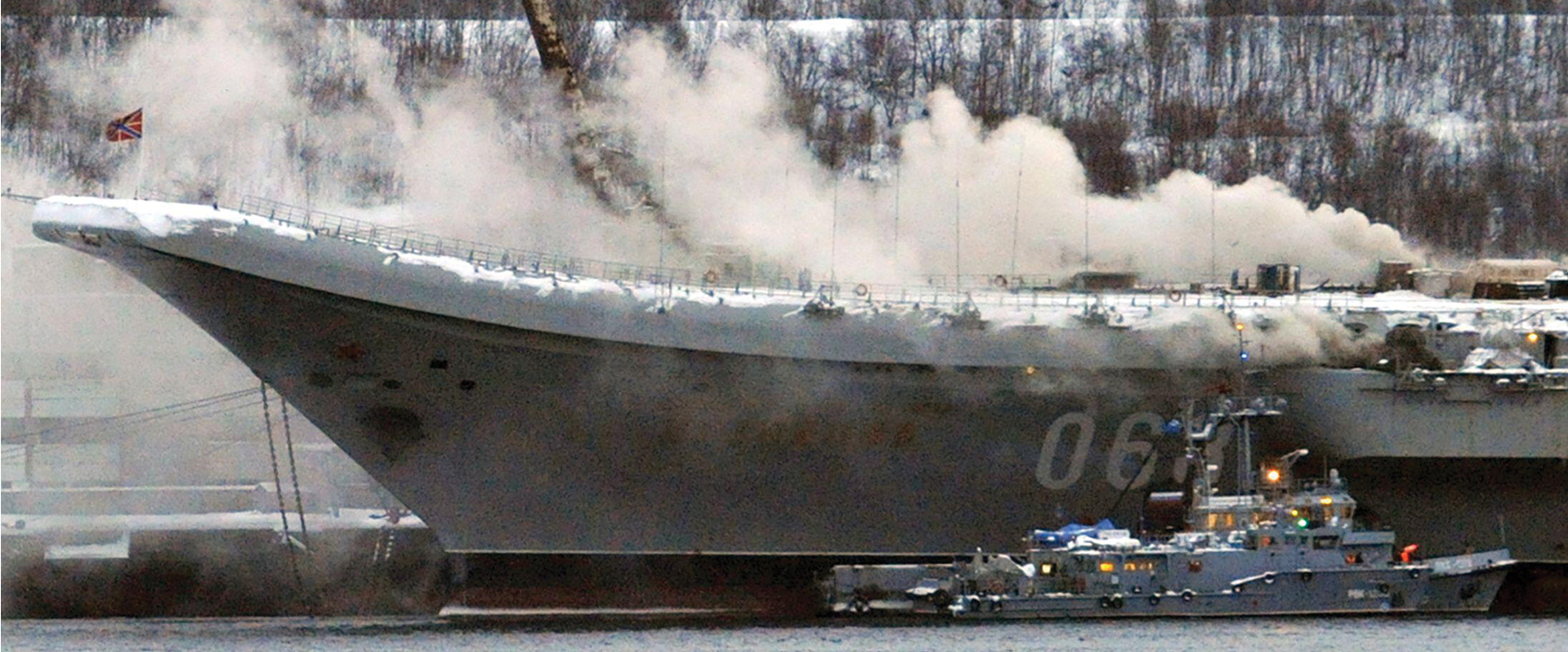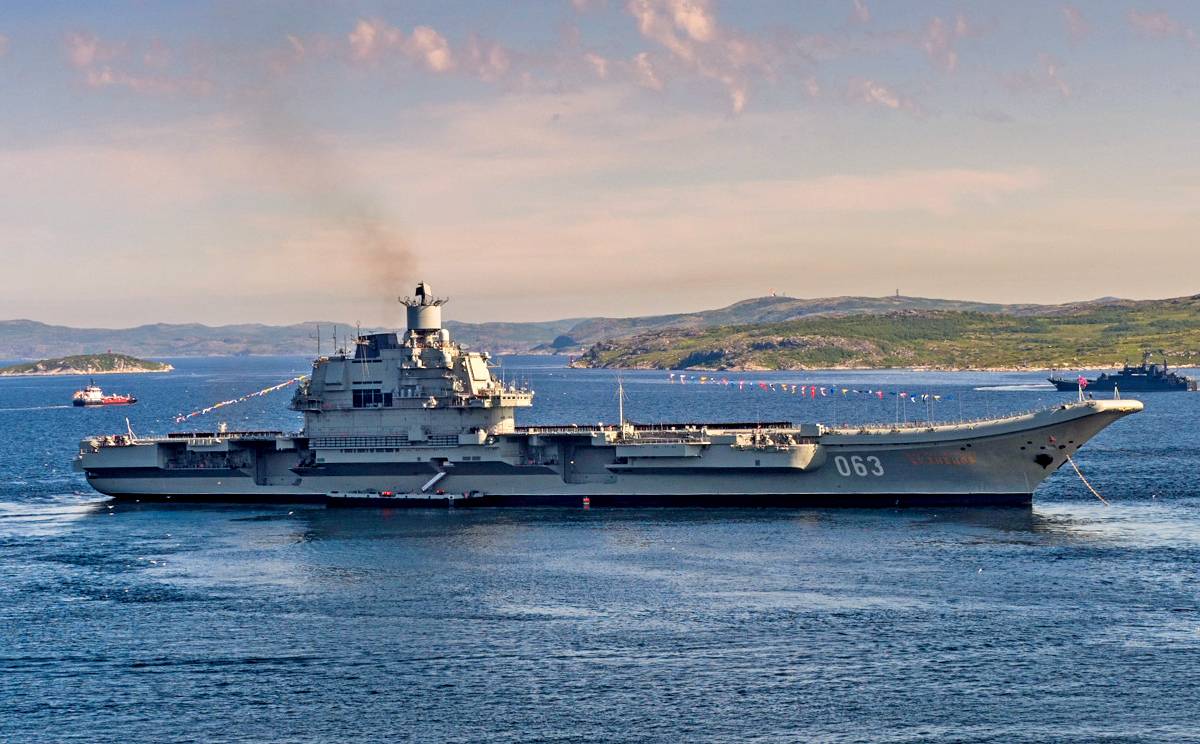Admiral Kuznetsov Smoke - Two intersecting lines forming an "X". Shows how to end an interaction or cancel a notification.
Home Chevron Icon Shows a section or drop-down menu or sometimes a previous / next navigation option. Contributor to the military and defense
Admiral Kuznetsov Smoke
/cloudfront-us-east-1.images.arcpublishing.com/gray/GPI6LKYZPRPCJN57RW563WQHQA.jpg)
Twitter icon Stylish bird with open mouth, tweeting. LinkedIn Twitter icon The word "in". Fliboard Icon LinkedIn Stylish Letter F. Flipboard Facebook Icon Letter F. Facebook Email Icon Cover. Shows the option to send an email. Email link icon Chain link image. This simplifies the URL of the link to the site. Copy the link
Mystery Solved: Why Russia's Aircraft Carrier Pumps Out So Much Black Smoke
Russia's only aircraft carrier had a problem: For most of the sailors who served on Admiral Kuznetz's ship, Mazut was a legend.
The ultra-thick tarry black substance that powers the ship is known to be quite toxic, sticky and not easily removed from clothing. But why did the Soviet Navy propel its ships with Mazut? What are the advantages and disadvantages of fuel? Why exactly is Kuznetsov so smoky?
Not all Russian ships run on Mazut. Of all the large ships currently operated by the Russian Navy, only the Sovremenny-class destroyer and the aircraft carrier Admiral Kuznetsov operate in Mazut. Given the Admiral Kuznetsov's high profile on the global stage – as Russia's only aircraft carrier – there is naturally a curiosity about what it is running and why it is producing so much smoke.
Fuel oil is a heavy petrochemical fuel. Although most sources state that it is taken from the bottom of the still, this is inaccurate because "fuel oil" is a general term for very heavy petroleum products, including those that can be made by blending heavier oils with some lighter ones. .
Sinking Of The Moskva, Black Sea Flagship Of The Russian Navy
In the West, Mazut will be included in the Bunker B and Bunker C fuel oil classifications, although ISO 8217 has replaced these categories. According to ISO 8217, Mazut can be classified as RMG or RMK fuel.
This dense and heavy fuel was standard for both military and commercial ships until the 1960s and 1970s. Their compact nature gives them a very high volume to energy ratio compared to lighter stills. However, to be burned, they often need to be heated and pressurized in a complex series of boilers and pipes.
Su-33, left, and MiG 29K, right, on the Admiral Kuznetsov off the coast of Syria, January 8, 2017. Andrei Luzik\TASS via Getty Images

Combustion of these fuels can also produce large amounts of sulfur, as the heavy mineral tends to settle at the bottom of still piles.
Russian Aircraft Carrier Admiral Kuznetsov On Fire
As a result, this fuel may be expensive to obtain in countries with higher environmental standards, as it must be distilled from crude oil with a low initial sulfur content or removed through chemical processes.
For this reason, Western navies began switching to gas turbine propulsion in the 1960s and 1970s. Gas turbines use natural gas and distillate fuel, not heavy bunker fuel. Currently, all US Navy ships use gas turbines for propulsion except nuclear powered ships or the Freedom class, which use electric propulsion systems.
Although the Slava-class cruisers built in the 1970s used gas turbines, the Sovremenny-class destroyers built at the same time were still designed with Mazut-powered propulsion systems, allegedly due to the inability of Soviet industry to produce enough turbines. in time, when. The Udaloy class destroyers then continued the trend of using gas turbines.
The big question is why Admiral Kuznetsov continues to use Mazut. Nuclear power is on the table because the Kirov-class battleships, designed at the same time, use nuclear power plants - although later Ulyanovsk-class carriers plan to use nuclear power.
Album] Russian Aircraft Carrier Admiral Kuznetsov Steams In The Med. Circa 2007.
One possible reason is that the class is based in part on the shape and hull layout of the earlier Kyiv-class aircraft carriers operating over Mazuta.
While Mazut was certainly not the optimal fuel choice for the Admiral Kuznetsov, its long and problematic construction process only exacerbated the problem.
A Russian news article described Kuznetsov as having a "weak heart" due to poor shipbuilding standards when she was completed in the 1990s at the Nikolaev Black Sea Shipyard in Mykolaiv.

The same admiral later described Kuznetsov's naval trials in the 1990s. Due to plumbing problems, all boilers cannot run at full power all the time and will often break down. Sometimes the ship was limited to single boiler operation, giving her a speed of around 4 knots.
Russia's Only Aircraft Carrier Admiral Kuznetsov On Fire As Infamous Cold War Ship Seen Belching Smoke In Mystery Blaze
These same reliability issues led the Russian Navy to send a tugboat to escort the Kuznetsov during its visit to the Syrian coast in 2016.
This technical difficulty was also cited as a potential reason for Kuznetsov's extremely smoky nature. Vice Admiral Pyotr Svyatashov explained that due to miscalibration in the preheater or the injection mechanism, the fuel oil injected into the combustion chamber may not burn completely—in other words, the partially burned product causes black smoke.
This is supported by some other analysts who say that exhaust color can be broadly divided into three colors - gray for oil, white for water and black for fuel.
Several blogs have done further analysis of the potential mechanical issues that can cause black smoke, even on Sovremenny class ships that have had their own black smoke attacks.
The U.s. Navy Feared Russia's Only Aircraft Carrier Could Sink
However, some Russian military experts have tried to completely downplay this issue. Admiral Ivan Vasiliyev said in the "Cargrad" program that the black smoke was a deliberate act to show the British that Admiral Kuznetsov was there, according to "naval tradition".
However, Russia may be working to solve the problem. Although the ship has been undergoing repairs for years with reports that the black smoke problem has been fixed, new information has been available for some time now about Russia's only aircraft carrier. Only Russia seems to know for sure.
Charlie Gao holds degrees in political science and computer science from Grinnell College and regularly comments on defense and national security issues.

NOW WATCH: Watch this US Navy aircraft carrier make an incredible high-speed lap in the Atlantic Ocean An aging Russian aircraft carrier sailing through the English Channel under Royal Navy escort has been plagued by years of technical problems and joined at anywhere with a tugboat. case it collapses.
Bremerton Man Jumps Out Of Burning Yacht, Rescues His 2 Dogs
The plumbing on the 55,000-ton Admiral Kuznetsov is so bad that many of its toilets are unusable, while it has suffered recurring power problems and a series of accidents, maritime experts said.
The Soviet-era warship is leading a fleet of eight naval ships to the eastern Mediterranean, where its aircraft are expected to join a new assault on the rebel-held city of Aleppo.
The Admiral Kuznetsov sailed through the Dover Strait on Friday with plumes of black smoke "marked at every turn" by the Royal Navy's HMS Duncan, the Defense Secretary said.
NATO officials said the Russian deployment was the largest of its kind since the Cold War and was designed to demonstrate Moscow's military power and also to bomb the only major rebel-held city in Syria.
Russian Aircraft Carrier Admiral Kuznetsov Travels Through English Channel
But as the ship sailed through the English Channel, marine enthusiasts mocked it on social media for its dire state of repair.
A Royal Navy source said: “All their ships look shiny on the outside but they're pretty scary on the inside. All you have to do is look at the smoke coming out to see that all is not well.
"For the past 10 years, we have had people on board Russian ships and it's always surprising. It's kind of crazy inside."

Peter Roberts, a maritime expert at the Royal United Services Institute, said: “In naval folklore there is something called an unlucky ship and the Kuznetsov was certainly an unlucky ship.
Deadly Blaze Hits Russia's Only Aircraft Carrier
Work on the Admiral Kuznetsov began in 1982 and it was commissioned in 1990. Since then, he said, it has been plagued by technical problems.
The ship was powered by steam turbines and turbo boilers, which were so unreliable that a large tug would accompany them when deployed in case the ship broke down.
Damage in the water pipe system means it freezes during the winter. To avoid burst pipes, the water is turned off in most huts and half the toilets are not working.
Mr Roberts, a former Royal Navy officer, said: "There is nothing sadder for a sea captain to leave home waters than to be escorted by a tugboat because even your commander-in-chief thinks you are going down.
Large Commercial Ship With Black Smoke Coming From Funnel On A Grey Day Near Falmouth, Cornwall, Uk Stock Photo
A sailor was killed when the ship caught fire during a visit to Turkey in 2009. The ship also spilled hundreds of tonnes of oil into the Irish Sea in a refueling accident the same year.
He said: "It's a big, fast and impressive ship with capable jets and it's going to war in Syria."
He said the Royal Navy still did not have its own aircraft carrier and Britain was only a decade away from having one

Admiral kuznetsov carrier, admiral kuznetsov, kuznetsov, admiral kuznetsov problems, admiral kuznetsov aircraft, admiral kuznetsov syria, the admiral kuznetsov, russian carrier admiral kuznetsov, admiral kuznetsov model, 1 350 admiral kuznetsov, russian admiral kuznetsov, admiral kuznetsov aircraft carrier

0 Comments